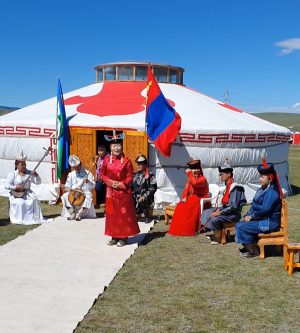Mongolia’s nomadic culture has deep historical roots. Even those who are not familiar with modern Mongolia will recognize the name Chinggis Khaan (also spelled Genghis Khan) and the Mongol Empire. Today, however, as Mongolia strives to modernize, its nomadic history and activities require international protection so that the younger generation continues to understand their own roots.
In recognition of the 20th anniversary of the 2003 UNESCO Convention on the Safeguarding of the Intangible Cultural Heritage, Mongolia organized the World Festival of Nomadic Culture in the Taij Khairkhan Valley last month. The festival attracted over 1,100 modern nomads, local artists, and craftsmen from 21 provinces of Mongolia. International representatives from China, Russia, South Korea, Turkey, Kazakhstan, Kyrgyzstan, and Hungary made the festival more vibrant and international.
Moreover, during the multi-day festival, UNESCO, the Institute for Central Asian Studies, the International Training Center for Intangible Cultural Heritage for the Asia-Pacific, and other organizations joined a consultative meeting for the adoption of the “Nomadic Living Heritage Safeguarding Declaration.”
Since the 1990s, Mongolia’s modernization process has posed a challenge to traditional nomadic lifestyles. As the younger generation continues to seek urban and technology-dependent lifestyles, nomadic aspirations were left to the very few – mostly of interest to historians, anthropologists, and archaeologists.
At the same time, Mongolia has established a system to preserve what is nomadic and culturally linked with the Mongol civilization with the help of UNESCO.
Since 2003, Mongolia has registered cultural artifacts and activities that are closely tied to the country’s nomadic history. Morin khuur, a horse-headed fiddle; biyelgee, a folk dance; and historic epic stories known as tuuli have all been registered on UNESCO’s List of Intangible Cultural Heritage.
Celebrations of nomadic culture play a crucial role in Mongolia’s effort to develop and modernize while preserving its history intact. Moreover, there an economic incentives to preserving Mongolian traditional culture. Alicia Campi, a leading Mongolian studies scholar, said that Mongols “have promoted the marketing value of these traditions to domestic and foreign audiences.”
UNESCO programs not only help Mongolia preserve cultural traditions that are closely linked to Mongol identity, but they also serve immediate protection for the environment. Given the close connection between nomadic culture and the environment, conservation is a particularly crucial step in preserving Mongolian traditions.
Government-protected mountains, ovoos, and lakes such as Burkhan Khaldun, Altan Ovoo, Orkhon Valley, and Uvs Lake Basin are protected as intangible heritage sites, a status that also grants them environmental protection. As Mongolia’s economy is heavily dependent on mining activities, the protection of these culturally and historically significant sites is a strategic move on the part of policymakers. Such preservation also marks an important milestone for Mongolia’s environmentalists, whose largest concerns directly connect to bad mining practices.
But there is much more to be done. According to the International Union of Conservation for Nature, “A total of 852 rivers, 1181 lakes and 2277 springs [in Mongolia] have gone dry because of irresponsible use of the land and natural resources. These impacts are likely to be further exacerbated by proposed new water transfer projects that are being built to supply water to mining operations.”
As Mongolia becomes more and more modernized and internationally recognized, cross-cultural activities and trends will branch out from the country’s nomadic roots. But as Mongolia continues to build a sense of national identity on its nomadic history, annual festivities and cultural activities that incorporate nomadic elements are deemed necessary – whether it’s for a domestic or foreign audience.
Hence, events like the World Festival of Nomadic Culture showcase Mongolia’s centuries-old nomadic culture to a very modernized audience. The exhibits of traditional arts and crafts, the gathering of local artists, and the practice of activities listed in the Intangible Cultural Heritage are both culturally and economically relevant.
In contrast to the many countries in the world with a historical memory based on settled civilization, nomadic traditions are often lost. Cultural elements that have shaped the history of many once-nomadic countries have been forgotten. From a cultural perspective, this explains the significance of Mongolia’s annual holidays and festivals such as Naadam, Tsagaan Sar, and the World Festival of Nomadic Culture.
This summer, Mongolia saw an increasing flow of tourists, especially during the summer Naadam festival in July, followed by the 100th anniversary of individual provinces. The current administration’s strategy, to combine Mongolia’s nomadic history with the tourism sector is both culturally and economically linked. In the next two years, Mongolia hopes to attract up to 1 million tourists per year.

































